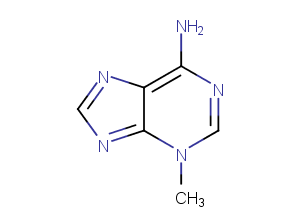1.Hou H, et al. Inhibitors of phosphatidylinositol 3'-kinases promote mitotic cell death in HeLa cells. PLoS One. 2012;7(4):e35665.
2.Wang S, Li F, Qiao R, et al. Arginine-Rich Manganese Silicate Nanobubbles as a Ferroptosis-Inducing Agent for Tumor-Targeted Theranostics[J]. ACS nano. 2018 Dec 26;12(12):12380-12392.
3.Heckmann BL, et al. The autophagic inhibitor 3-methyladenine potently stimulates PKA-dependent lipolysis in adipocytes. Br J Pharmacol. 2013 Jan;168(1):163-71.
4.Kosic M, et al. 3-Methyladenine prevents energy stress-induced necrotic death of melanoma cells through autophagy-independent mechanisms. J Pharmacol Sci. 2021 Sep;147(1):156-167.
5.Dai S, et al. Systemic application of 3-methyladenine markedly inhibited atherosclerotic lesion in ApoE-/- mice by modulating autophagy, foam cell formation and immune-negative molecules. Cell Death Dis. 2016 Dec 1;7(12):e2498.
6.Li Q, et al. Inhibition of autophagy with 3-methyladenine is protective in a lethal model of murine endotoxemia and polymicrobial sepsis. Innate Immun. 2018 May;24(4):231-239.
7.hang C, Liu Z, Zhang Y, et al. Z“Iron free” zinc oxide nanoparticles with ion-leaking properties disrupt intracellular ROS and iron homeostasis to induce ferroptosis[J]. Cell Death & Disease. 2020, 11(3): 1-15.
8.Shang Z, Zhang T, Jiang M, et al. High-carbohydrate, High-fat Diet-induced Hyperlipidemia Hampers the Differentiation Balance of Bone Marrow Mesenchymal Stem Cells by Suppressing Autophagy via the AMPK/mTOR Pathway in Rat Models[J]. 2020.
9.Xia Y, Chen J, Yu Y, et al. Compensatory combination of mTOR and TrxR inhibitors to cause oxidative stress and regression of tumors[J]. Theranostics. 2021, 11(9): 4335.
10.Zhang H, Cui Z, Cheng D, et al. RNF186 regulates EFNB1 (ephrin B1)-EPHB2-induced autophagy in the colonic epithelial cells for the maintenance of intestinal homeostasis[J]. Autophagy . 2020
